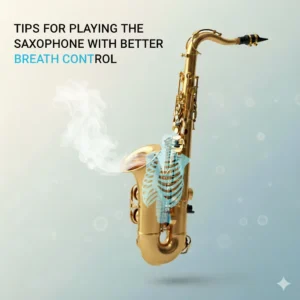Saxophonists require the right kind of breath control, which you should know. Do you feel breathing problems when playing a saxophone? That happens without proper technique, which leads to unstable sounds. With the right techniques, your breath control can get better. Endurance is a big feature of breath control for saxophonists. For better sound quality in saxophones, you need to master them. You need the right tips for playing the saxophone with better breath control. Once you have followed them, saxophone playing becomes fluid.
Mastering Breath Control Techniques For Better Saxophone Performance
Learning saxophone breath control is important for better saxophone performances. Diaphragmatic breathing is the basis that works. This breathing technique helps to expand lung capacity for saxophonists. If you’re a beginner at playing saxophone, you need to learn this. For better airflow, breath control is important here. Some techniques include relaxing your shoulders as a start. As you inhale, expand your abdomen. For a controlled exhale, use your abdominal muscles the most. Regular exercise can also help you as a saxophonist. This builds stamina, which you’ll need.
Tips to Improve Lung Capacity and Breath Support for Saxophone Players
Breathing techniques –
Practice diaphragmatic breathing:
Saxophonists need to place a hand on their stomach. The next step would be inhaling deeply and properly. Your stomach should also expand. Also, your shoulders shouldn’t be raised while doing this. Other than that, keep the chest relaxed and not raised as well. This is also known as “belly breathing”.
Focus on controlled exhalation:
Here, you need to use your abdominal and core muscles. Start pushing air out slowly in a gentle manner. You have to keep it steady to avoid forceful exhale. To sustain notes and long phrases, do this. A squeezing exhale should be avoided here, as it comes from the throat.
Inhale from the bottom up
Your chest should slightly expand as we breathe. This should happen when you take a full breath. The focus here remains on filling the lower part of your lung. Your abdomen also plays a part here, so inhale according to that.
On-instrument exercise –
Play long notes:
Play sustained notes for a balanced tone on your saxophone. To keep it steady, use your breath control consciously.
Inhale through the corners of your mouth:
Prepare yourself before you start performing with the saxophone. For that, breathe through the corners of your mouth. With your lips on the mouthpiece, doing this helps with breath control. A deep breath works even better here.
Specific exercises –
Tactical Happy Breath:
Use this technique for happy breath:
- Inhale for a count of four
- Hold for four
- Exhale for four
- Hold for a count of two
Posture and conditioning –
Maintain good posture:
Your posture must be tall so that your lungs expand better. You can stand or sit during this. To set a base for your breath, use your core muscles here.
Engage your core:
While playing the saxophone, use your core. This is important for saxophone playing and breath control. Engaging your core is important.
Other important tips –
Stay hydrated:
This happens as hydration keeps the mucosal linings in your lungs thin. This improves lung function so you can perform better with saxophones.
Avoid smoking:
Lung diseases can be caused by secondhand smoke, which is not a good look here. To be a good saxophonist, you should avoid smoking to the most. Saxophonists need good breath control to be better at playing.
Use a resistance tool:
You can use breathing trainers as they actually help saxophonists. By using a Power Breather, you can build strength for a better output. You can start with low resistance as a beginner and then slowly increase it.
Conclusion
To be better at playing saxophone, breath control matters. You need to be extremely good at breathing exercises as a base. Tools like Power Breather can be used here, which actually help. You need to inhale properly with the right breath control.
FAQs
Q – How to breathe control when playing a saxophone?
A – When playing a saxophone, breathe in through the corner of your mouth. If you do this with your lips on the mouthpiece, then it works.
Q – How is saxophone lung prevented?
A – Saxophone is prevented when your saxophone is cleaned out properly. Saxophone lung is a dreaded condition that you should avoid.
Q – Do strong lungs help saxophonists?
A – Yes, strong lungs do help saxophonists, as the capacity matters. Airflow is an important factor for saxophones. With better breath control and strong lungs, you become better.
Q – How do lungs get stronger?
A – Here are some of the ways you can make your lungs stronger:
- Exercise
- Deep breathing exercises
- Avoiding pollutants





